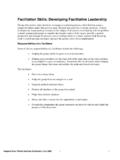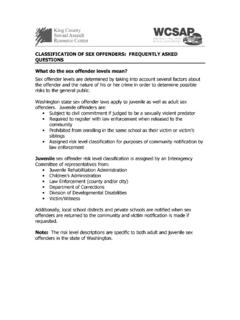Transcription of Gang Enforcement Problems and Strategies: National …
1 gang Enforcement Problems and strategies : National Survey Findings*. By Claire M. Johnson**. Barbara A. Webster Edward F. Connors Diana J. Saenz Abstract Federally-sponsored surveys of 149 police departments and 118 prosecutors' offices of jurisdictions greater than 250,000; and 73 prosecutors' offices of jurisdictions of 50,000 to 250,000 residents examined the Problems and needs of law Enforcement agencies, and the strategies they use in combating gangs. Findings show that the vast majority of police and prosecutors consider gangs and gang -related violence to be a major problem . The most common prosecutor tactics are the use of confidential informants, computerized gang intelligence systems, and street level buy-bust operations are the most common police tactics; and participating in special gang Enforcement initiatives, policies discouraging reduction of charges against gang members, and access to computerized gang tracking systems.
2 For prosecutors, obtaining the cooperation of victims and witnesses is cited as the most significant problem , followed by intimidation of witnesses. Introduction In recent years, law Enforcement agencies in large and small jurisdictions have experienced increases in gangs and gang -related violence and struggle to stretch diminishing resources to develop and implement gang Enforcement strategies . To date, however, there are limited National estimates of the severity of the gang problem in the United States. The Institute for Law and Justice (ILJ) recently conducted two federally-sponsored studies that examined the 1. Problems and needs of law Enforcement agencies, and the strategies they use in combating gangs. The Bureau of Justice Assistance (BJA) sponsored a National study of law Enforcement strategies directed at urban street gang violence and drug trafficking, and the National Institute of Justice (NIJ) sponsored a similar study of prosecutors' offices.
3 The studies will help BJA. and NIJ better assist law Enforcement agencies develop programs and strategies to control and prevent gang activity. Prior Research Gangs have been the topic of research for decades, but interest in studying them has grown in recent years. With the proliferation of gang violence and crime, increasing numbers of gang members, and the spread of historically localized gangs to other cities and states, the need for gang research has become more compelling. Most studies of gangs focus on specific types of gangs, like the Crips and Bloods or Asian gangs, or particular areas known for gang activity, like Los Angeles or Chicago. There is a paucity of studies that have a National focus, and few of the National studies are recent, offering little guidance on current issues and developments in the nature and activities of urban street gangs. The majority of studies are descriptive in nature, examining the organizational structure and activities of gangs, and the sociodemographic and criminal histories of gang members.
4 Fewer studies focus on what measures law Enforcement agencies and communities undertake to deal with the gang problem . Among the few National surveys are Miller's 1975 investigation of 12 cities known to have youth gang Problems , and Needle and Stapleton's 1983 study that examined law Enforcement perspectives in agencies in 60 cities. More recent surveys include the 1992. Law Enforcement Mail Questionnaire Survey conducted by Knox, et al, which obtained estimates of the extent and severity of the gang problem from urban police chiefs and county sheriffs in 787 cities with populations greater than 25,000 and 703 component counties of metropolitan areas. 2. One of the most noteworthy recent surveys is the National Youth gang Survey, which was conducted from 1988 to 1990 as part of the four-year, federally-funded National Youth gang Intervention and Suppression Program (Spergel and Curry, 1992). The purpose of this survey was to identify and assess promising approaches and strategies undertaken by any organization engaged in organized efforts specifically intended to address the youth gang problem .
5 Data were gathered from 254 criminal justice and community-based organizations in 45 cities. The survey particularly examined the presence of networks that involved the unified effort of several agencies participating in youth gang prevention, intervention, and suppression programs. A follow-up analysis was done of the 21 urban areas that had four or more agencies participating in a community-level program to deal with youth gang -related Problems . ILJ's surveys of police departments and prosecutors' offices in cities throughout the United States focus on perceptions and estimates of the gang problem and anti- gang strategies employed by these criminal justice agencies. Methodology The BJA survey of police departments was sent in April 1992 to approximately 175. agencies serving jurisdictions with populations greater than 250,000, and had a response rate of 85 percent (149 departments). The survey was designed to gather general information about the current status of gangs in reporting jurisdictions, and particular information on approaches police departments applied to address the Problems .
6 A majority of the survey was devoted to the tactics used by departments in general or specialized gang units. The questionnaire survey was followed by a telephone survey that focused on cities with significant gang Problems , with emphasis on police departments that have specialized gang units. However, the follow-up also included a 20 percent sample of police departments with no specialized gang unit. The lack of a gang unit does not preclude the existence of a gang 3. problem . The telephone survey included open-ended questions to learn more about Enforcement of particular gangs and gang Problems . The NIJ-funded survey of prosecutors' offices included 368 agencies. All 175 counties with populations greater than 250,000 were included in the sample group. The other 193. prosecutors' offices were randomly selected from counties of 50,000 to 250,000 residents. Three hundred agencies (81 percent) responded, 109 (36 percent) of which indicated that they had no gang problem .
7 The analysis is based on the 191 completed surveys (118 from large and 73 from small jurisdictions) of prosecutors stating they had a gang problem . Overview of the gang problem Findings from both surveys provide insight to the extent of the gang problem nationwide. In general, nearly 87 percent of the sample police agencies consider gangs a problem in their jurisdictions, and nearly 16 percent rate gangs as a major problem (Exhibit 1). Eighty-seven percent of responding police agencies believe that the number of gang members have increased in their jurisdictions in the past three years and 83 percent of agencies report that citizen complaints on gangs have increased in this period (Exhibit 2). Eighty-four percent of responding agencies feel that the level of gang -related violence has increased in the past three years and 83 percent indicate that the number of guns confiscated from gang members has increased in this time (Exhibit 2).
8 The police sample also reports that the average number of gangs in a jurisdiction is 28, and the average number of gang members is approximately 1,632. Among prosecutors, 78 percent of respondents in both large and small jurisdictions report increases in gang -related violence. More than 70 percent of all gang types in large jurisdictions are reported to be involved in violent crime. The proliferation of gang crime has impacted prosecutors' caseloads and is evidenced by the number of gang -related violent crimes prosecuted per month. The average number of cases is two to four per month in small jurisdictions and 25 to 29 in large jurisdictions. The effect is especially significant for large 4. jurisdictions, where more than one-fifth of prosecutors have more than 30 gang -related violent crimes to prosecute per month (Exhibit 3). Defining Gangs Considering the extent of the gang problem in cities nationwide, there is relatively little attention given to researching differences between gang members and non- gang members.
9 Furthermore, there is no uniform definition of gang or how gangs are distinguished from "delinquent groups." Sheldon, et al, note that ".. modern researchers have argued that gangs and delinquent groups are significantly different. Specifically, most researchers now agree that gang offenders are usually older, more homogenous with regard age, sex, race and residence and tend to commit more violent crimes than ordinary 'delinquent groups.'" (Sheldon, et al, 1992). However, Horowitz states that for research purposes, "It is not necessary to agree on the parameters of what constitutes a gang . Agreement will likely never be achieved, and definitions often obscure problematic areas and may not encourage the development of new questions." (Horowitz, 1990). The importance of defining gang -related terms, however, must not be understated. How broadly or narrowly agencies define gang , gang member, gang - related crime and other terms will significantly affect the development of gang intelligence databases, classification, assessment of the gang problem , strategic planning, evaluation, and application of gang -specific legislation (Spergel and Curry, 1992).
10 For the police survey, definitions of gangs and gang members were not provided. These terms and the severity of the gang problem were left to each jurisdiction to define. The survey specifically addressed Enforcement strategies directed at groups that were defined by an agency as a gang , so a general term of gang member was sufficient for these purposes. In the prosecutors' survey, ILJ found that 44 percent of prosecutors in large jurisdictions classify any crime committed by a gang member as a gang crime, whether the outcome of the crime benefits the gang or not. However, another 44 percent in large jurisdictions define a gang crime as only a crime committed by a gang member for the benefit of 5. the gang . In some large jurisdictions, only crimes committed by a targeted gang leader or crimes of violence are treated as gang -related, an even more narrowly focused approach. While prosecutors in large jurisdictions are divided in how they defined gang -related crime, they are more likely than small jurisdictions to use the broad definition of gang crime to classify any crime committed by a gang member as gang -related.








